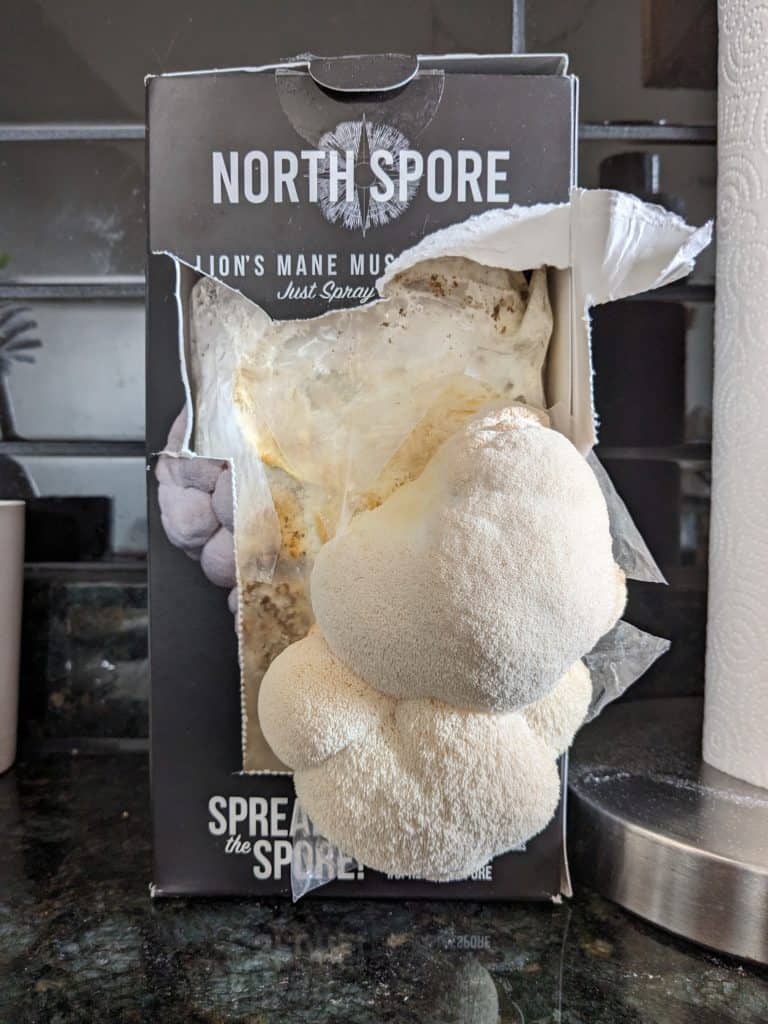I purchased the North Spore organic lion’s mane mushroom kit at a supermarket (Woodman’s in Buffalo Grove, Ill.) The store sold it for only $20. I’m not sure if North Spore has agreements with other retailers, but locally scoring a kit might save you ten bucks. On the other hand, the online bag may be fresh and packed-to-order. I have no idea how long my kit sat on the shelf.
Even if my kit was old, the spores were healthy. I got four nice flushes of lion’s mane mushrooms. A couple years ago at a Whole Foods, I purchased a carton of lion’s manes for $10. (They were already soggy and yellow inside, but the price works anyway for reference.) If each flush was worth about $10, the kit paid for itself, even at a $30 online price.
The rotten lion’s manes I bought at Whole Foods were not organic. Mushrooms, as opposed to a fast-growing plant such as cilantro, are a type of organism that soaks up and stores many different elements and compounds from its environment. Some mushroom species even absorb radioactive compounds. I wouldn’t want to grow mushrooms off a spore block that had been treated with conventional agrochemicals. Seeing the USDA-certified-organic badge on the North Spore kit was a huge bonus.
So was the kit “worth it” as far as culinary, health, or spiritual value? Absolutely! I adored the taste of the lion’s mane mushrooms. The funny thing is I can’t tell you how they tasted. Each mushroom seemed different. Sometimes I thought they tasted like chicken. Sometimes maple syrup. Tasting and preparing them over and over was a treat.
I prepared them as simply as possible. I sliced them. Then I sautéd them in hot butter and used a long, flexible spatula to press them down into the pan, which is like a lazy way of doing a Japanese technique I saw for cooking a maitake mushroom “steak” by placing a weight on top. Toward the end of cooking I sprinkled them with salt and pepper.
The speed and simplicity of this preparation kept the shroom kit from becoming a chore. The kit said to harvest them before they began to yellow. Each time I saw the hue of a tiny spine/tooth of a mushroom start to change, I’d harvest the entire kit, cook them all, and eat them in less than 30 minutes. This kept the mushrooms from becoming just another ingredient going bad in my kitchen. I never had to plan a dish or meal around them. Plus, I thought it wouldn’t do justice to the lion’s mane to cook it into a stir-fry or a soup.
Each time I ate the lion’s manes, I thought they were tasty, and then I did the dishes and forgot about them, just like all the other tasty things I eat. But then, the strangest thing would happen. Forty minutes later, I’d have a thought about the lion’s manes again. I’d remember the smell of the mushroom when I broke it off the mycelium block, and then I’d remember the smell of the mushroom when it was cooking. Over the next two to six hours, all kinds of intrusive thoughts about the lion’s mane would pop into my head. Thoughts of the texture of the mushroom when I chewed it up. Thoughts of the physical appearance of the spines/teeth and the way they felt when I handled them on the cutting board. These little half-formed sense-memories pushed their way into my mind like a mushroom pushing up from the ground!
Probably it was possible to coax more than four flushes from my North Shore lion’s mane kit, but I went on vacation. The day before leaving, I set up a cup of water with a string leading to the mycelium block. I thought the mushroom could “feed itself” by sucking water from the string. I forgot about siphons. In less than an hour, siphon power sucked all the water out of the cup and deposited it into the kit and all over my countertop.
The cardboard box and plastic bag of the lion’s mane kit were completely soaked in water. I drained as much as I could, then propped up the kit and left for my trip. I figured that was the end. Imagine my surprise when I returned a week later and was greeted by a large, crude-looking lion’s mane.

This was the only fresh food in the house! Right away I cooked and ate it.

That fourth flush turned out to be my last. After that, I sprayed every day for more than two weeks. Meanwhile, the exposed surface of the mycelium block turned more gold, brown, and black. I found no more pins. I decided to compost the kit in a local waterway (Bubbly Creek). When I took the block out of the plastic, I saw plenty of healthy-looking white mycelium on the three sides of the block that’s been covered by cardboard. I guessed I could have tried slicing a different side of the package to coax out another flush, but I’d already committed to setting the mushroom free. Down Bubbly Creek it flowed, perchance to grow.








